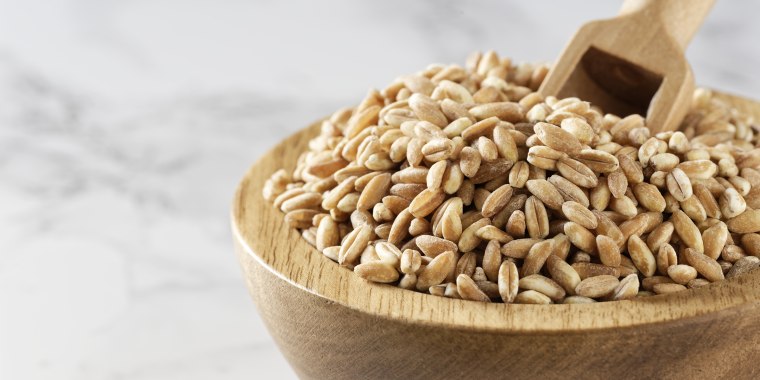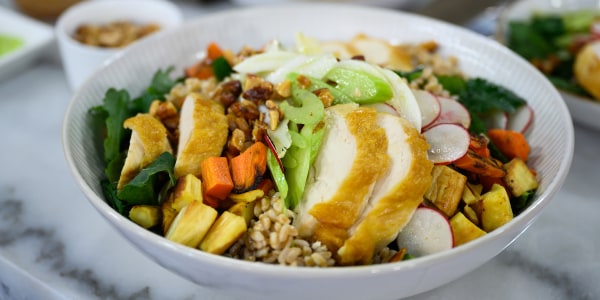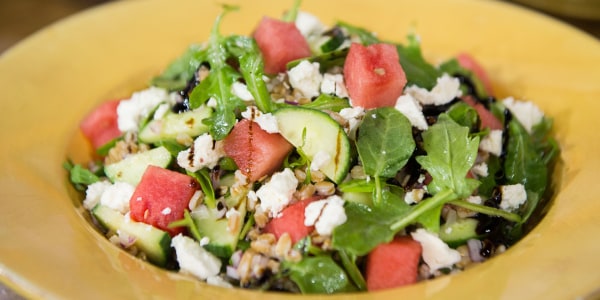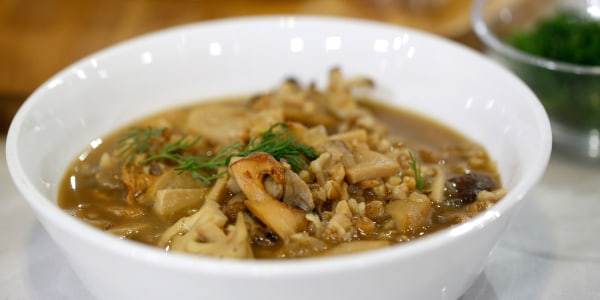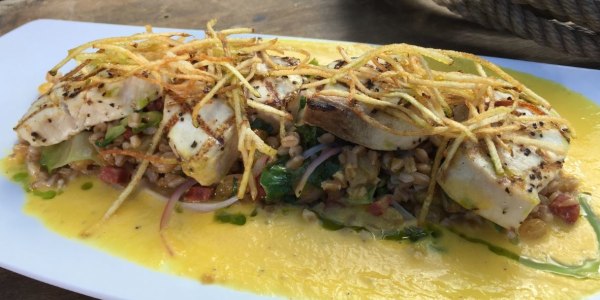With plant-based lifestyles gaining in popularity, ancient grains are becoming staples in modern diets. While quinoa has been big for the last few years, another fiber-rich grain is receiving a lot of well-deserved praise for its nutty taste and robust texture.
Perhaps you've seen farro in grocery store aisles, or maybe you've tasted it in soups, salads or side dishes. This pearl-like grain is delightfully hearty and holds up well in a variety of uses. But is it really any better for you than rice?
If this ingredient has not yet made its way into your kitchen — or heart — it's time to change your routine. Here's everything you need to know about cooking with and enjoying farro.
What is farro?
Farro is a whole grain that, similar to most ancient grains like quinoa, has been cultivated the same way for thousands of years, according to nutritionist and "Eating in Color" author Frances Largeman-Roth. Specifically, farro (also called emmer or einkorn) is a type of hulled wheat. While it's not gluten-free, it's great for individuals looking to incorporate more plant-based proteins into their diets.
"The texture is very satisfying, so if someone is trying to eat less meat, they may find it helpful to include farro in meals," Largeman-Roth told TODAY Food.
Why is farro becoming more popular?
Trisha Calvo, Consumer Reports deputy editor of health and food, has noticed more people turning to farro and other ancient grains as they look beyond diets like keto and Atkins that favor higher fat contents and more animal protein.
The Mediterranean diet, for example, encourages eating fruits, vegetables, healthy fats and whole grains. This year, it was ranked as the best overall diet for the third year in a row by U.S. News & World Report. Even large fast-food chains have been adding more meatless options to their menus to keep up with demand.
"All whole grains are healthy — packed with fiber and other nutrients and help reduce the risk of heart disease, type 2 diabetes, and other illnesses. But farro stands out for its complex nutty flavor and versatility," Calvo told TODAY.
In 2019, market research firm Mintel reported that 32% of people aged 55 and older (even those who consider themselves carnivores) have been trying to eat more plant-based meals amid a wave of new studies demonstrating the benefits of diets that are high in fiber and rich in complex carbohydrates.
Is farro healthy?
Absolutely, says NBC health and nutrition editor Madelyn Fernstrom. Farro is a nutrient-dense grain with little fat, plus it's high in fiber and high in protein. It is also a good source of vitamins A and E, magnesium and iron.
A one-cup serving of farro has 220 calories, 2 grams of fat, 47 grams of carbohydrates, 8 grams of protein and 6 grams of fiber. Per serving, farro has the same amount of protein as quinoa, but nearly double the amount of protein of both white and brown rice. Out of the four, farro also has the most fiber (quinoa and brown rice have 5 grams per serving, while white rice has half a gram).
A cup of quinoa, by comparison has about 220 calories, 3 grams of fat, 40 grams of carbohydrates and 5 grams of fiber.
Ready to dig in? Farro is easy to make
According to Brian Doyle, executive chef of Rockrose, a Mediterranean restaurant in New Orleans, farro is simple to prepare, even for beginners.
To make farro:
- Add 3 cups of liquid (preferably broth or stock) to a sauce pot.
- Add 1 cup of farro (the ratio should always be 3 to 1) and bring to a boil. Turn down the heat and simmer for about 25 minutes, until the grains are tender but still chewy.
- Drain the farro and reserve it, hot or chilled. It can be added to soups, salads, stews or eaten on its own .
To give farro a more elevated flavor and texture, just add an extra step. Doyle recommends first simmering diced onions in a generous amount of olive oil in a pan on medium heat until they become translucent. Then add in the raw farro. Coat the farro in the oil, cook it for about 5 minutes until it begins to smell nutty and then add in diced garlic and herbs like thyme or Greek oregano. Once the farro is toasted, add it to a separate pot of boiling chicken stock and simmer for 25 minutes — following the same instructions as above.
For folks short on time, some brands, like Trader Joe's 10-minute farro, offer quicker cook times.
While cooking farro is pretty straightforward, chef Donald Moore, chief culinary officer at The Cheesecake Factory, says the one avoidable mistake is undercooking it.
"Some people are sensitive to eating farro that’s undercooked because they find it to be too ‘wheaty’ and the moisture (from the broth, oil and butter) helps to make it almost risotto-like while also intensifying the nutty flavor," Moore told TODAY.
Doyle refrains from pairing farro with delicate seafoods like scallops or very flaky fish, as its chewy texture and flavor can sometimes overpower the main protein.
Craving more fun farro dishes?
Farro can be used in just about any number of cuisines and courses. Swap out your favorite oatmeal dish for a warm bowl of farro served with a dollop of yogurt, nuts and fresh fruit. Keep a large batch in the fridge for easy, on-the-go lunches or serve it under a big portion of vegetables and your favorite lean protein for a satisfying grain bowl at dinner time. You can even swap farro flour for all-purpose to make cookies more nutritious.
"I love farro because it is just as delicious hot as it is cold — it works in warm soups and chilled salads," Doyle said. "I love to add farro in as a substitute for rice in dolmades (stuffed grape leaves). It's easy to prepare and a great appetizer or snack."
Calvo cooks farro with bay leaves and a cinnamon stick, then enjoys it warm, tossed with chickpeas and golden raisins. Moore, on the other hand, uses farro as the key ingredient in veggie burgers and often incorporates it as the principle grain in Italian risottos and Indian-style pilafs.
No matter how you decide to use it, farro deserves a regular spot in your weekly meal rotation. And just like that, what's old is new again.
